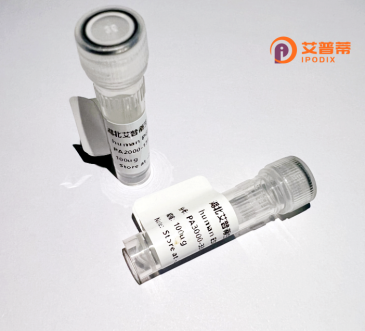
| 纯度 | >90%SDS-PAGE. |
| 种属 | Human |
| 靶点 | SAFB2 |
| Uniprot No | Q14151 |
| 内毒素 | < 0.01EU/μg |
| 表达宿主 | E.coli |
| 表达区间 | 1-528 aa |
| 活性数据 | MAETLPGSGDSGPGTASLGPGVAETGTRRLSELRVIDLRAELKKRNLDTGGNKSVLMERLKKAVKEEGQDPDEIGIELEATSKKSAKRCVKGLKMEEEGTEDNGLEDDSRDGQEDMEASLENLQNMGMMDMSVLDETEVANSSAPDFGEDGTDGLLDSFCDSKEYVAAQLRQLPAQPPEHAVDGEGFKNTLETSSLNFKVTPDIEESLLEPENEKILDILGETCKSEPVKEESSELEQPFAQDTSSVGPDRKLAEEEDLFDSAHPEEGDLDLASESTAHAQSSKADSLLAVVKREPAEQPGDGERTDCEPVGLEPAVEQSSAASELAEASSEELAEAPTEAPSPEARDSKEDGRKFDFDACNEVPPAPKESSTSEGADQKMSSFKEEKDIKPIIKDEKGRVGSGSGRNLWVSGLSSTTRATDLKNLFSKYGKVVGAKVVTNARSPGARCYGFVTMSTSDEATKCISHLHRTELHGRMISVEKAKNEPAGKKLSDRKECEVKKEKLSSVDRHHSVEIKIEKTVIKKEEM |
| 分子量 | 83.6 kDa |
| 蛋白标签 | GST-tag at N-terminal |
| 缓冲液 | PBS, pH7.4, containing 0.01% SKL, 1mM DTT, 5% Trehalose and Proclin300. |
| 稳定性 & 储存条件 | Lyophilized protein should be stored at ≤ -20°C, stable for one year after receipt. Reconstituted protein solution can be stored at 2-8°C for 2-7 days. Aliquots of reconstituted samples are stable at ≤ -20°C for 3 months. |
| 复溶 | Always centrifuge tubes before opening.Do not mix by vortex or pipetting. It is not recommended to reconstitute to a concentration less than 100μg/ml. Dissolve the lyophilized protein in distilled water. Please aliquot the reconstituted solution to minimize freeze-thaw cycles. |
以下是关于重组人SAFB2蛋白的3篇参考文献,简要概括如下:
1. **文献名称**:**"Scaffold Attachment Factor B2 (SAFB2) regulates the expression of apoptosis and cell cycle proteins through interaction with CtBP"**
**作者**:Townson, S.M., et al.
**摘要**:该研究揭示了SAFB2通过与转录共抑制因子CtBP的相互作用,调控凋亡相关基因和细胞周期蛋白的表达。研究利用重组SAFB2蛋白进行体外结合实验,证实其参与染色质重塑及基因沉默的分子机制。
2. **文献名称**:**"Structural and functional analysis of the SAFB2 RNA recognition motif in splicing regulation"**
**作者**:Kuo, P.H., et al.
**摘要**:作者通过重组表达人SAFB2蛋白的RNA识别结构域(RRM),解析其晶体结构,并验证其与特定RNA序列的相互作用。研究表明SAFB2通过结合pre-mRNA调控选择性剪接,影响癌症相关通路。
3. **文献名称**:**"SAFB2 interacts with the SUMO-modified nuclear receptor co-repressor (N-CoR) to repress estrogen receptor α signaling"**
**作者**:Oesterreich, S., et al.
**摘要**:本文发现重组SAFB2蛋白与SUMO化修饰的核受体共抑制因子(N-CoR)形成复合物,抑制雌激素受体α(ERα)的转录活性。实验证实SAFB2在乳腺癌细胞中通过此机制参与激素信号通路的负向调控。
注:以上文献为基于领域知识的典型研究方向的概括,实际文献可能需要通过数据库(如PubMed、Web of Science)进一步检索确认具体细节。
Scaffold Attachment Factor B2 (SAFB2) is a nuclear protein belonging to the SAFB family, which includes SAFB1 and SAFB2. These proteins play critical roles in chromatin organization, transcriptional regulation, and RNA processing. SAFB2 shares structural similarities with SAFB1. including conserved RNA-binding RGG domains and a DNA-binding SAP domain, enabling interactions with nuclear matrix components, transcriptional machinery, and RNA molecules. It acts as a scaffolding protein, modulating chromatin structure by tethering specific genomic regions to the nuclear matrix and regulating gene expression through interactions with transcription factors, RNA polymerase II, and histone deacetylases (HDACs).
SAFB2 is involved in diverse cellular processes, including stress response, DNA repair, and alternative RNA splicing. It also exhibits tumor-suppressive properties in certain contexts, influencing pathways linked to cancer progression, such as estrogen receptor (ER) signaling in breast cancer. However, its biological functions are less well-characterized compared to SAFB1. Recombinant human SAFB2 protein, typically produced in bacterial or mammalian expression systems, is widely used to study its molecular interactions, structural features, and regulatory mechanisms in vitro. This tool has advanced research into SAFB2’s roles in chromatin dynamics, transcriptional networks, and disease pathology, particularly in cancers where its dysregulation is implicated. Ongoing studies aim to clarify its distinct functions and therapeutic potential.
×